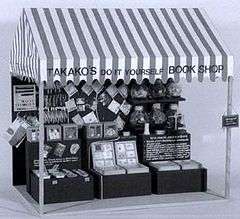Takako Saito
Takako Saito (born 1929) is a Japanese artist. Closely associated with Fluxus, the international collective of avant-garde artists that was active primarily in the 1960s and 1970s, Saito contributed a number of performances and artworks to the movement, which continue to be exhibited in Fluxus exhibitions to the present day. She currently lives in Düsseldorf in Germany. She is most famous for pieces like Silent Music or for her special Chess sets.
Takako Saito | |
|---|---|
| Born | Takako Saito |
| Nationality | Japanese |
| Education | Psychology |
| Known for | Visual Art, Artist's Multiples, Installation, Sculpture, Performance, |
| Movement | Fluxus |
Early life

Saito was born in Sabae-Shi, Fukui Province in Japan. Five Years after studying psychology at the Japan Women's University, she became involved with Sōzō Biiku undŏ, the 'Creative Art Education' movement. Founded 1952 by Sadajirŏ Kubo, the movement focussed on encouraging creativity through free will.[1] Whilst attending a summer camp organized by the movement, Saito met a Tokyo member Ay-O, an artist actively engaged in encouraging avant-garde groups in Japan. Ay-O became an important source of information for Saito about the avant-garde, first in Tokyo, and then, later, in New York City, where he moved in 1958.[1] Intrigued by the reports being sent back by Ay-O, Saito also travelled to New York in 1963 ostensibly to work as a designer for a textile wholesaler and later studying at NY university, Brooklyn Museum Art School and Art Student League. It was through Ay-O that she was introduced to George Maciunas, founder and organiser of Fluxus, and one of the central members of the New York avant-garde.
Fluxus
George Maciunas was fascinated by Japanese craftsmanship and owned some Japanese boxes. He was so impressed with Saito's craftmanship that he asked her to contribute a series of disrupted chess sets to sell in his new Flux shop on Canal Street, SoHo, New York. Maciunas was so delighted by Spice Chess in particular that he 'even took credit for it on occasion.'.[2] Even after developing some distance to Fluxus Saito maintained contact with him until Maciunas' death.
"After a while, Maciunas proposed having dinner together every evening. In his opinion, buying food for many was more economical than buying for one... He called it Flux Dinner Commune. So George, Paik, Takako, Shigeko and I started this part-time collective life. For the first few days, the men went shopping and the girls cooked. However we found it inconvenient, because George came back rather late from his office and then often didn't buy what we wanted to cook.... It didn't last long, because we got jobs at night. George was discouraged, but bravely said, "Well, work comes first, dinner second." Mieko Shiomi [3]
Saito remained part of the Fluxus movement throughout the 1960s and 70s,[4] producing multi-media, installation and sculptural work in collaboration with other artists such as Robert Filliou, George Brecht, Dorothy Iannone, Gerhard Rühm, Ben Vautier, Dick Higgins and Bob Watts. Saito has contributed pieces to many Fluxus collaborations, including Fluxus 1 (1964) and the Flux Cabinet (1975–77).[4] She is perhaps most well known for her "Silent Music" piece. Her output was diverse and she is also remembered for the various special chess sets including Smell Chess and Spice Chess, and that were often included in the Flux Boxes from 1964 onwards, which was part of a Fluxus series of game variations of Chess.
Travels

Saito left New York in 1968, leading a peripatetic lifestyle until 1978. Saito lived in France, Germany, England and Italy, working with George Brecht, Robert Filliou, and with the Beau Geste Press, publishing artist's books.[5] From 1979 to 1983, she taught at the University of Essen. Later pieces have maintained the fluxus ideal of eroding the boundaries between performer and viewer;
'Saito's You and Me Shop again includes the idea of exchange with the viewer and of collaborative artistic work. In a small shop resembling a market stall, the artist as sales woman offered an arranged selection of those small things or materials which she also used in her objects: dried onion skins, chestnuts, pieces of wood. Here, the interaction with the viewer started with the joint selection, placement and fixation of the offered items on paper plates. It ended with the handing over of the object to the respective participant.' Virtual Museum of Modernism [5]
Aside from solo exhibitions in Düsseldorf, Cologne, Fukui, New York, Kansas, Bremen, Kaunas and Schwerin, she has featured in recent exhibitions including Fluxus retrospectives at the Chapel Studio in Balatonboglár in 2002 and at Tate Modern London in 2008 and the Re-Imagining Asia at the House of World Cultures in Berlin.
Düsseldorf
Since 1978, Saito has been living and working in Düsseldorf.
References
- Into Performance, Yoshimoto, Rutgers University Press, 2005
- Fluxus Codex, Hendricks, Abrams, 1989 p461
- Quoted in Mr Fluxus, E Williams and A Noel, Thames and Hudson, 1997, p129
- Oxford Art Online (subscription only)/ Fluxus
- Virtual Museum of Modernism